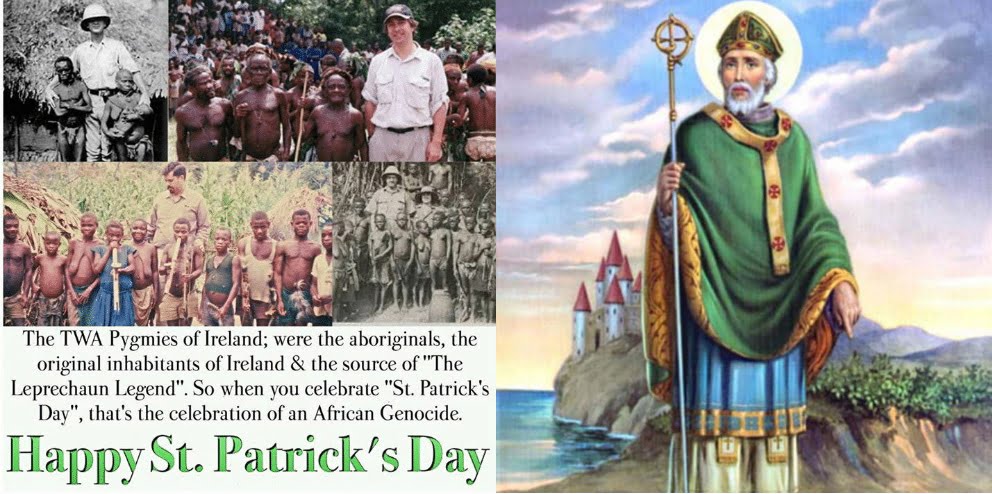Recently, a theory has been circulating on social networks according to which the patron saint of Ireland is responsible for the genocide of the ancient inhabitants of the island - representatives of the pygmy race. The latter, in turn, allegedly became the prototype of the heroes of Irish folklore - leprechauns. We checked how plausible this story is.
The theory began circulating on social networks in the 2010s, both in the form of lengthy posts and in the form of memes. This is what one of the viral ones said: publications on this topic:
“The Twa pygmy tribe... the mythical Twa leprechauns. The Africans who migrated to Ireland over 10,000 years ago had advanced knowledge of metallurgy and medicine that Europeans considered "magical". Among the earliest settlers were the Twa, a tribe of black pygmies who migrated north from Africa and made the island nation their home. Research strongly suggests that the Twa were the first inhabitants of Northern Ireland, long before the Druids and the beginning of the influence of the Roman Catholic Church. The history of some of the Twa can be traced back to more than 10,000 BC. e. People from other cultures have migrated to Ireland in more recent times, mainly from the Middle East and Eastern Europe. Genetic analysis carried out by Dan Bradley from Trinity College Dublin reveals the roots of ancient Irish genomes in Spain and Sardinia. Their other ancestors, as the study showed, lived on the territory of modern Russia and Ukraine. So, as proud as the Irish are of their origins, they appear to be a genetic mixture of peoples from Europe, the Middle East and Asia. The only people of original Irish descent are the Twa people, who still inhabit the jungles in various parts of Africa. The Twa Pygmies were the first settlers in Ireland.
Where are they now? The old legend of St. Patrick driving the snakes out of Ireland appears to be a distorted account of Patrick's genocide against the Twa. The Twa are said to have worn the uraeus, a special headdress with images of snakes, also popular among the Egyptian pharaohs. Thus, the Catholic Church apparently honors St. Patrick for his part in the massacre of the Twa people throughout Northern Ireland. <…> And behind the myth of leprechauns there are also short black people killed in the name of religion. Many Irish legends, passed down by the Druids to this day, reflect the existence of the Twa. Lore about leprechauns, green cloaks, and pots of gold coins states that they had special knowledge of medicine, metallurgy, weaving, and shoemaking, which were considered "magical" by Caucasians. As a result of the mass genocide led by Patrick, acting on behalf of the Catholic Church, the Twa were deprived of all their goods. Because the native people of Ireland were dark-skinned Africans, there was a misconception that they were pagans, but this is not true. They may have been more culturally advanced than the European raiders who eventually took over their lands and drove them out. The next time St. Patrick's Day rolls around, it looks like we'll once again be celebrating the extermination of an entire human race by order of the Vatican."
One of the popularizers of the theory was the psychologist, speaker and fighter for the rights of African Americans B. F. Nkrumah, who wrote down the corresponding video.
Let us consider the main facts and provisions appearing in this theory. In all respects it corresponds to the doctrine called Afrocentrism. It is an approach that emphasizes the unique role and achievements of Africans in the evolution of Western civilization. Echoes are also visible here euhemerism, whose apologists believe that religious myths were the result of the worship of real people.
Twa (or Batwa) is a very real pygmy people, living in Central Africa. Not on the verge of extinction, but also not numerous (about 300,000 people), the tribe is serious suffered during the Rwandan genocide. Semi-historical theories that somehow mention the Twa tribe did not appear today. There was a great article on this topic published in 2007 on the website of one of the communities in the American city of Kansas City. Among the notable things there are the statement that the Twa were known in Europe as "elves", as well as an attempt to connect the snake-like dreadlocks on the head of the Twa tribe with the legend of the snakes expelled by St. Patrick. The mention of such difficultly compatible images as the ancient Egyptian demiurge Ptah and the Hindu energy of kundalini deserves special attention. All this speaks of the attempts of the authors of the theory to tie at least some facts to each other, even if they belong to different eras and peoples.
As often happens, the blog authors tried to support historical statements with arguments on the topic of etymology. According to their version, the word “leprechaun” can be divided into lexemes (le-pr-rah ka-hn), corresponding to the African roots le (lion, king), pr (house, temple), re/ra-rah (sun, lion), ka (soul in Egyptian mythology). Not only is the strange phrase “the spirit of a lion in the king’s house” here traced back to ancient Egyptian culture, not pygmy culture, but it also contradicts scientific etymology, according to which the word leipreachán comes from Old Irish roots with the meanings “small” and “body”.
This is about Afrocentrism. Now about the euhemeristic origins of the theory. The euhemerists, whose pseudo-historical works were especially popular more than 100 years ago, sought to explain well-known fairy tales and myths through historical facts. One of these authors was retired Iowa lawyer James Anderson, who in 1911 published “Mysteries of prehistoric times" He theorized that some Pygmies were the first settlers of parts of the Old World, including Ireland: “The first inhabitants of Southern Europe, North Africa, Arabia, France and the British Isles were a race of short people, whose average height did not exceed 4 feet 5 inches (135 cm - Ed.). They were of thin build with dark complexions. <…> They were an African people, and there is evidence that their representatives sometimes practiced cannibalism.”
There are several elements that immediately discredit this text by Anderson. Firstly, in his description of the habitat of these pygmies, he mentioned Lemuria - a fictional ancient continent, the existence of which was soon completely refuted. Secondly, he calls the first inhabitants of Ireland the Formatians - a tribe unknown to science, which, apparently, is an erroneous name for mythical giants Formorians. And, finally, he also goes into the etymological jungle, in defiance of all scientists, elevating the toponym Belfast to the name of the god Baal.
Another Anatoly Fomenko of his time was a Scottish folklorist David MacRitchie, whose works (also largely built on “folk etymology”) could become the basis for the theory included in our title. One way or another, modern scientists reject all these assumptions.
The earliest archaeological evidence of human habitation on the island of Ireland dated beginning of the 11th century BC e. In order to populate Ireland at that time, the Twa, who lived far from the sea in Central Africa, had to have, firstly, the skill of building fairly advanced ships, and secondly, to be skillful and experienced sailors in order to get on such ships in sufficient numbers to an island located many thousands of kilometers from their home. This assumption looks fantastic, and science simply does not know adequate evidence in its favor.
As for St. Patrick and the snakes, all excavations indicate that these animals were never found on the island. The legend is believed to be a metaphor for the Christianization (and decline of paganism) of Ireland, in which a British priest plays a significant role. If he ever existed, of course.
Fake
Read on topic:
1. Did St. Patrick Wipe Out an African ‘Pygmy’ Tribe, the First Inhabitants of Ireland?
2. Ancient Origins of Leprechauns Bes the Black Twa Man
3. Kairn A. Klieman. The Pygmies Were Our Compass.
If you find a spelling or grammatical error, please let us know by highlighting the error text and clicking Ctrl+Enter.







